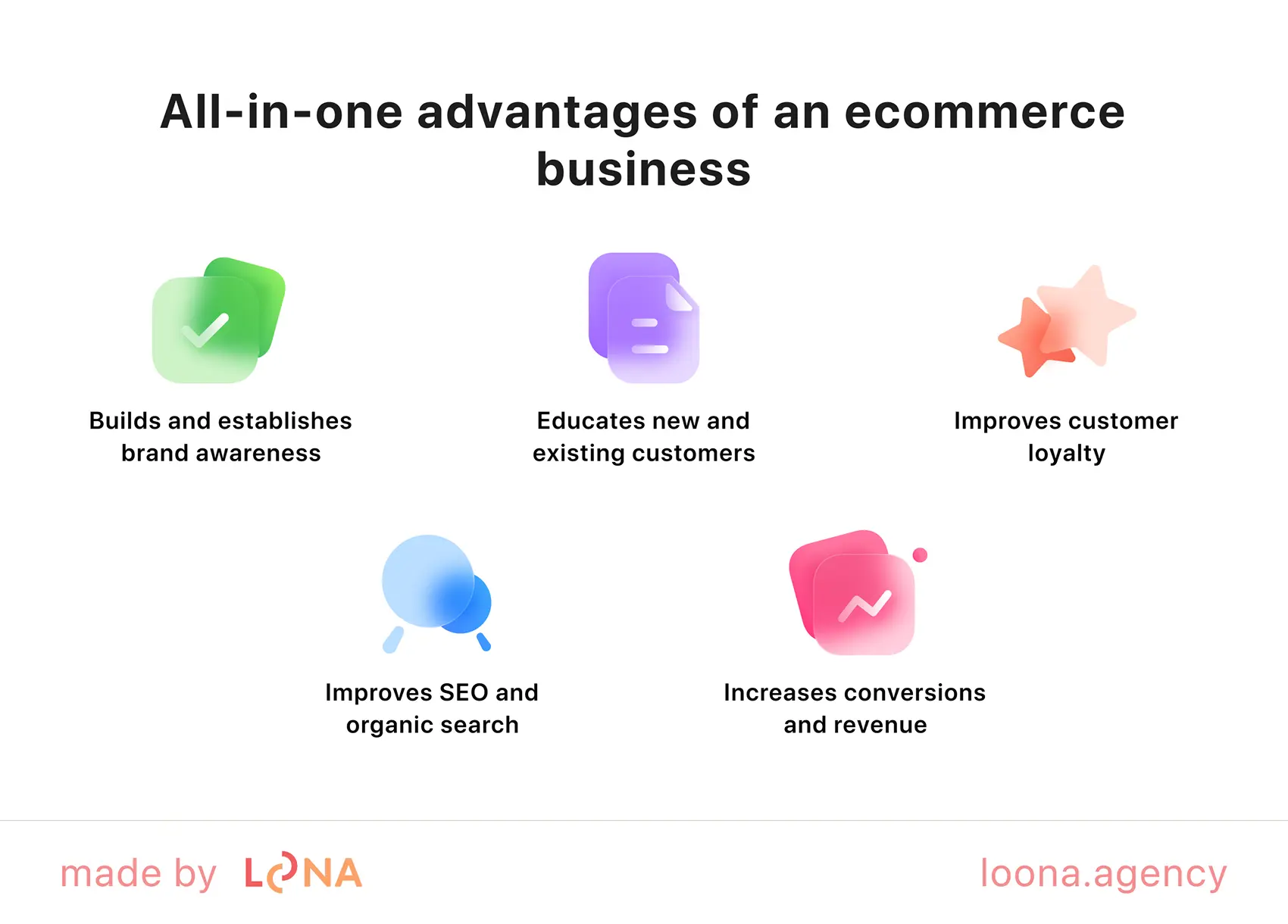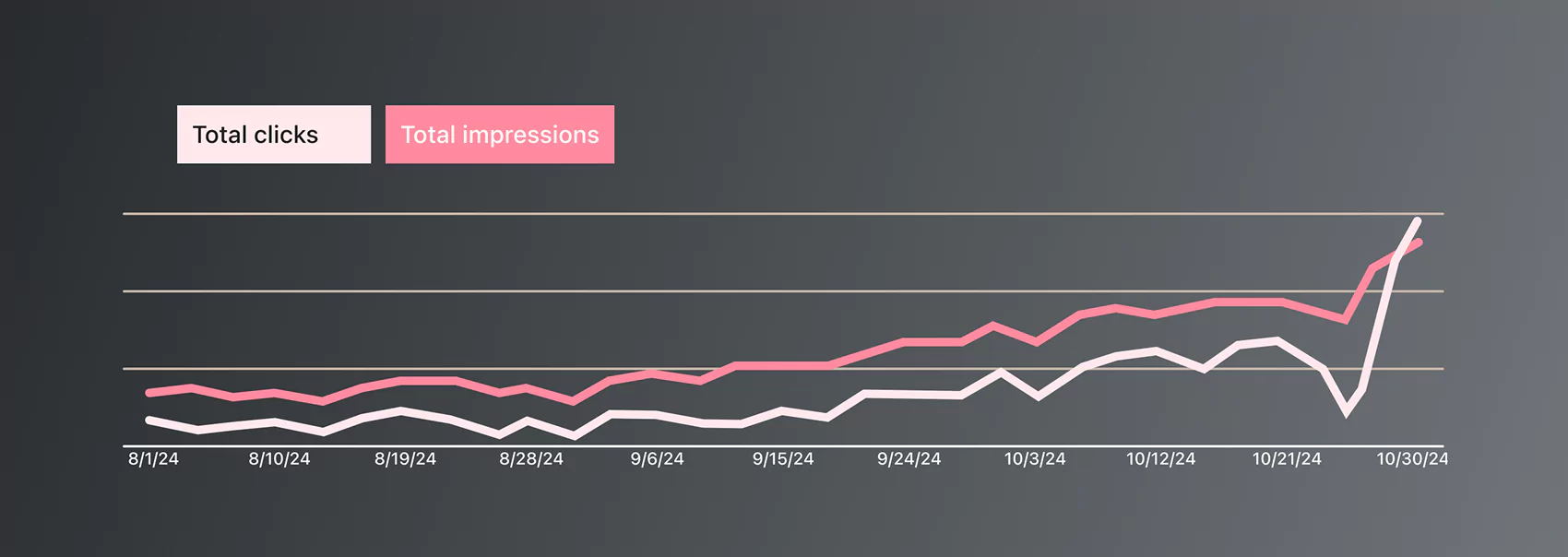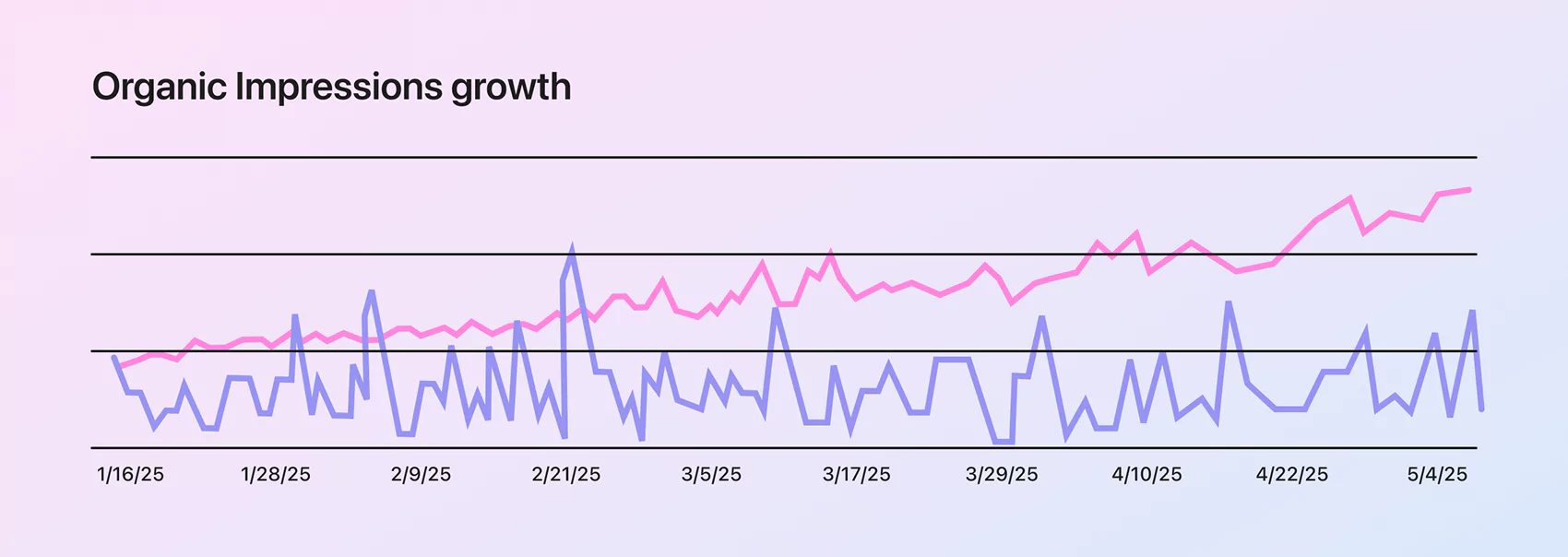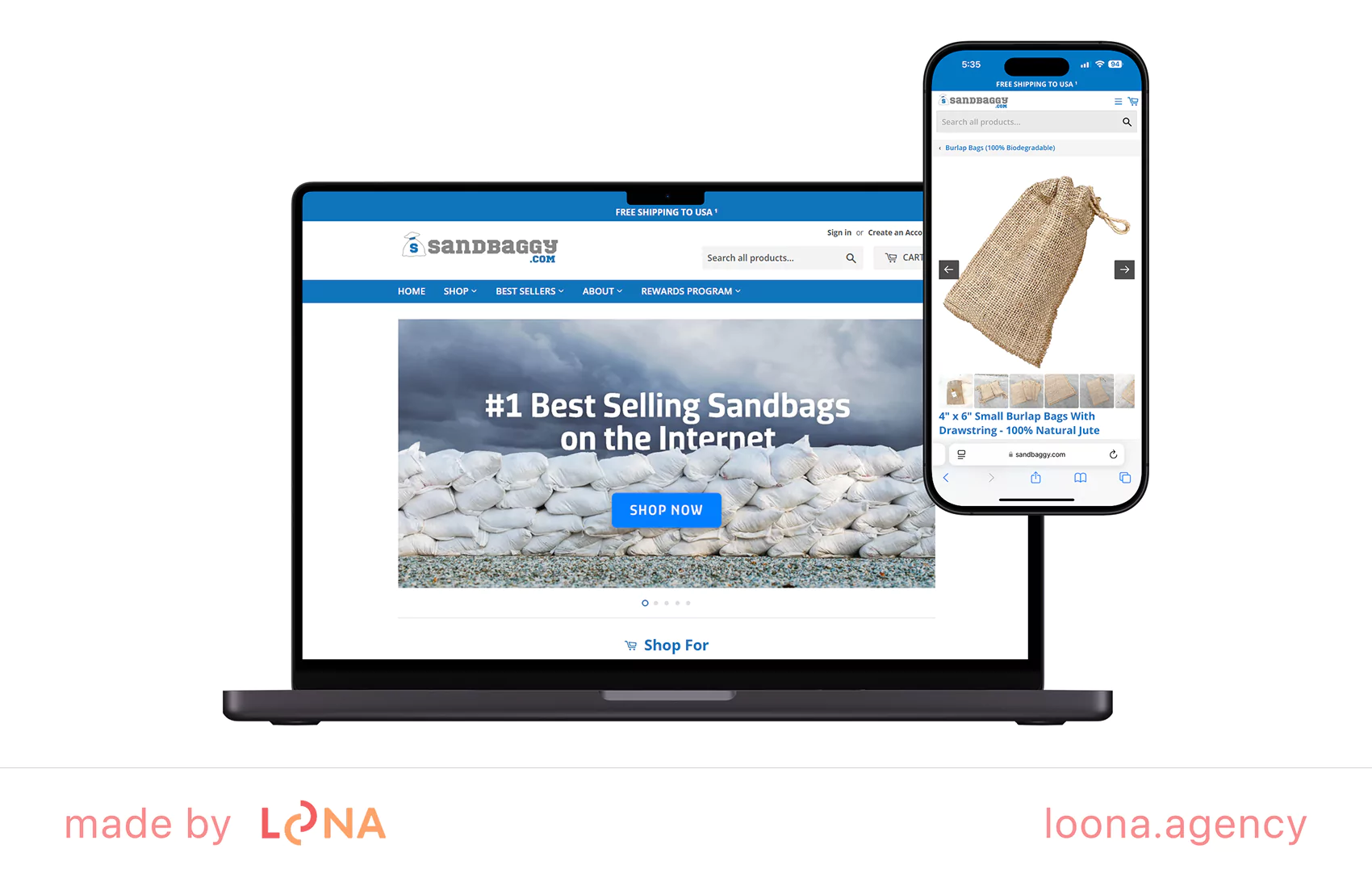How Ecommerce Content Marketing Can Skyrocket Your Sales and Brand Growth

Content is gradually making its way further into the sales funnel. Automation permits us to sell things to anyone, at any time. There are methods that can draw potential clients wherever they are, whether on social media, websites, or when checking email. However, market rivalry and the battle for trends make content marketing ecommerce a two-edged sword. Want to learn it? Loona Agency explains more in this article!
What is ecommerce content marketing?
In the early 2000s, it seemed tough to conceive of someone purchasing items via a computer. In 2025, more individuals will buy online than in physical stores. Buyers are no longer interested in lengthy product descriptions or all of the manufacturer's specifications.
They seek a fix to their struggles with the appropriate [in their perspective] "price-quality" ratio. Content marketing informs those who are most likely to purchase the things being advertised, while it does not address the goods themselves. So, why are some catalog products not selling?
Navigation map like a clue.
Old-style product page or website design.
Advertisements that pop up before you can blink.
Loading time takes longer than 3-5 seconds.
Non-clicking or unresponsive buttons.
The way you communicate with your audience determines the destiny of your business. Customers in 2025 are fussy, researching the market, quality, and reviews as thoroughly as possible. Therefore, online purchasing begins with a few hours of searching on Google or Bing.
People are looking for the answer to a circumstance, and no matter how special your offer is, if a more competitive offer is available, they may choose another. As a result, content marketing ecommerce is an integral part that must be properly considered.
Why ecommerce businesses need content marketing now
Unlike traditional marketing, which often overwhelms audiences with product-focused advertising, e-commerce content marketing aims to develop expertise, enhance brand awareness, and maintain consumer interest in the company. The types of content used in these strategies range from blog posts to podcasts. Each is selected based on its effectiveness in reaching the target audience and achieving engagement goals.

By offering users high-quality content that is relevant to their interests and needs, companies build relationships with their audience. According to MarketResearch, in the United States, the e-commerce content marketing market is worth $49.5 billion in 2024.
The global ecommerce content marketing shows a prediction of growth of 19.8% CAGR between the evaluation periods of 2024 and 2030, leading to an estimate of the year 2030 of reaching the market size of $517.6 billion.
Types of content that drive ecommerce sales
What is the content strategy ecommerce? It is a linked system with distinct stages of control, analysis, and results. When views leave much to be desired and sales figures fall short of expectations, it is worth considering boosting content using search algorithms. Merely 29% of marketers report having a written, truly effective ecommerce content strategy, although 88% expect budgets to increase by 2025.
User-generated content
User-generated content (UGC) refers to any content developed and published by unpaid authors or platform users. Fundamentally, it is text, photographs, and videos created and shared by users or customers on their own initiative. When consumers see actual individuals using and praising a product or service, they are more likely to trust the brand and consider purchasing.
The best content for ecommerce will provide what the customer wants. This is what makes UGC valuable: it delivers a level of authenticity and trust that traditional advertising cannot match. How can it be demonstrated in practice? Loona Agency helps Avva Experience (a company that heads virtual team-building) with boosting visibility in search engines and attracting users.

Our goal was for the client to achieve excellent results, with organic traffic increasing by 950% in just a few months, impressions doubling, and CTR rising by nearly 100%. Moreover, the blog's content and robust backlink strategy gain DR to +100%.
Product pages’ content
What to do if the number of visits can reach several thousand per day, but the conversion and sales are almost zero? You need to review the product page and find suitable ways to optimize deals. Ecommerce website content must have intuitive navigation and no glitches. Some paramount tips are mentioned in the table below.
Category | Implementation |
Navigation | Content creation for ecommerce website implies a variety of categories and subcategories of goods. Thus, you can provide flexibility to the user. Basic functions, such as "go back to the choice of goods" or "view similar offers," will enhance navigation and create the necessary convenience. |
In-page image design | Buyers decide whether to deal with your product based on the description and visuals you provide. A 360-degree view is a customer-friendly feature that can help enhance conversion. Whether you use 3D or 2D photos, ensure the content aligns with the description on the webpage. |
Rating and reviews | Ecommerce content marketing strategy is focused on the customer's desire to purchase something that they do not already have. The primary aim is to generate a sense of urgency, encouraging people to act quickly and avoid spending too much time considering purchasing your product. |
Cross-selling and related goods | There is a current trend of displaying associated goods on product pages. This will raise your average cart value and conversion rate. Showcasing related products for cross-selling is an effective approach to introduce customers to other offers they may not have been aware of. |
The user experience is the most pivotal factor that potential consumers consider when visiting your website. As a result, in the absence of personal conversation as the primary persuasion mechanism, the usability and appearance of your product page must be adjusted to convert visitors into customers effectively.
E-commerce content marketing strategies that work
Content marketing for ecommerce sites necessitates adaptability and multiple ways of engaging clients. Such alternatives include native advertising or an invitation to view related products in the cart. In any event, the ecommerce content marketing strategy must take a holistic approach, beginning with "why the customer wants to buy the product" and ending with "how to push the customer to buy".
Brands shelled out a record-breaking $8 million for a single 30-second [Super Bowl] ad — all for a fleeting moment in front of an audience glued to their screens,” Soubhik Dawn, Upplai founder, said in the Forbes interview. “Why? Because in those 30 seconds, companies must grab attention, tell a compelling story, and leave a lasting impact or risk being forgotten.
Job seekers face the same challenge. Studies show that recruiters spend just 3-7 seconds scanning a [content] before deciding if it’s worth a deeper look. Just like a [Super Bowl] ad, a resume needs to captivate immediately, communicate value, and differentiate the candidate from the competition.”
Marketing for ecommerce has to be a stairway in which the customer goes up to the selling. The first step has the highest value. Therefore, the buying process cannot fog up the prime stages and crack the business sales. How to deal with a content marketing strategy for ecommerce website? Check the table below.
Content strategy | Specification |
The elephant in the bee | The brevity of a content strategy for ecommerce is what makes it hard. That is, to pack a lot of information into ten seconds of a promotional video. For purchasers, memorable content starts with clarity: what is the position, and why do we need this product?. This point of view serves as a filter for everything else, including format, tone, and dissemination. |
Call to action without pushing | A lot of information should be shown to customers in just ten seconds of a promotional video. For purchasers, memorable content begins with clarity: what is the position, and why do we need this product? This point of view serves as a filter for everything else, including format, tone, and dissemination. |
Soft AI-accessible structure | Marketers must organize their material in a way that AI bots can easily access and extract information from. Aligning with Google's E-E-A-T standards indicates credibility, relevance, and timeliness. Brands that implement these content modifications will be visible to their target audiences. |
Big-budget companies will be out of reach for small enterprises, whilst corporations and businesses must seek out specific answers to their struggles. As a result, each specialty requires a distinctive strategy. Loona Agency consistently developed custom solutions for each company, helping the LOOPO media project management app gain greater online visibility and reach a wider audience.

We focused on making Loopo's media management software as accessible as possible to support their rapid growth. The organic click-through rate (CTR) grew by 1.3%. By changing our ecommerce content marketing strategy, our team was able to help with achievement and retain the №1 ranking for all branded keywords in my target markets for three months, alongside acquiring over 4,400 new users.
SEO tips to maximize ecommerce content marketing Impact
Search engine algorithms promote the overall content strategy ecommerce. Product description, style, and even photos can influence how quickly customers notice your product page on Google. To be ideal, a firm must be able to function with vital indications and interpret graphs, which we shall go over in detail below.
Analyzing traffic and content
Unlike traffic that comes from paid advertising (such as Google Ads), organic traffic is generated by your website's natural listing in search results, which is determined by how well it is search engine optimized. Getting organic traffic is a long-term process that becomes more effective as your site's rankings rise.
Sure, donating to an ecommerce content strategy might bring people to your site quickly by targeting specific keywords or graphs, though it stops without payment. While generating major organic traffic takes time and continuous SEO (search engine optimization) procedures, the rewards far transcend the commitment.
Once your site ranks highly for specific keywords, you will continue to attract visitors without having to pay for each click. It offers a long-term, scalable content marketing strategy for ecommerce for gaining visitors, as opposed to sponsored ads, which require continual expenditure.
Every blog post, video, or social media update they make provides you with a direct view of what does and doesn’t work in your business. Ignoring your competitors might result in decreased traffic, rankings, and conversions. The one that matters is whether you deal or not. Look at enhancing your content subjects, forms, and delivery to surpass competitors in the market. Pay attention to the following points:
top-rated competitors;
audit content strategy;
SEO performance;
inside applying.
Before you can exceed your competitors, you need first to comprehend who they are and how they gained popularity. Many brands make the mistake of focusing solely on direct business competitors and ignoring others with good content.
The idea is to compile a list that prioritizes which rivals are most dear to your plan. Concentrate on those things that could gain high content marketing ecommerce. It is most relevant to your company's goals.
Metrics that you can’t ignore
Analysts receive an abundance of information on search engine optimization. This contains statistics ranging from the number of common words in a request to more complicated ones, like conversion rate. In any event, the outcomes of the measurements determine the content marketing strategy for e-commerce business. We will go over them in greater detail in the table below.
Parameter | Definition |
Content marketing ROI (return on investment) | Return on investment (ROI) is one of the top cases. For example, if you made $2,000 from organic social content after investing $500, your ROI is 300%. In B2B content marketing analytics, social media acts as a platform for creating beneficial collaborations, making it a tangible value to your content marketing ecommerce efforts. |
Impressions | This measure represents the total number of times material, such as a commercial or a social media post, is displayed or presented to people on a certain platform. For example, if a Thread's post appears 10 times in users' newsfeeds, it receives 10 impressions. To track impressions accurately, use the analytics tools supplied by each platform separately. |
Traffic sources | Analyzing traffic sources can reveal the most effective routes for driving people to your website, including social media, organic search, referral links, and direct traffic. Furthermore, evaluating the variety of traffic sources allows you to broaden the scope of your advertising and reach a larger audience. |
Average engagement rate | On your website, this indicator represents the percentage of engaged sessions, as determined by Google Analytics or another tool. They include user actions, such as staying on your website for more than 10 seconds, completing conversion events such as booking a demo or contacting your company, and moving across many pages or screens. |
Click-through rate (CTR) | Click-through rates can vary depending on where the customer is in their analysis of the page map via your digital marketing funnel. A high CTR indicates that a piece of content piques the user's interest when it appears in the search engine results page. This is an option for risk management. |
By aligning with targeted ROI results, such as leads or purchases, you may estimate the traffic and conversion rates required.
Whether you're changing content kinds for higher CTR or optimizing distribution approaches, keep in mind that e-commerce content marketing is a big investment. However, all of your efforts will be worthwhile in the long run, bringing your firm engaged clients and profit.
Metrics are not limited to tracking numbers. The content strategy ecommerce must be constantly updated and adapted based on data analysis. Regularly review your results, adapt your approach, and use new ideas to enhance your content quality.
Real-life ecommerce content marketing examples
In turn, ecommerce content marketing examples demonstrate how you can boost your position in a month. Loona Agency demonstrated this in the Sandbaggy (e-commerce provider of durable construction and garden products) case.
Sandbaggy has dreamed about a double-digit rise in organic traffic. We substantially enhanced their online performance, achieving a +100 % increase in views flow growth within just a few months. The goal was to rebuild and optimize Sandbaggy's product pages to boost online exposure, provide a better user experience, and maximize conversions.

Elise Dopson, an ecommerce content marketer, mentioned another example in Harris Sid's interview. She said about a creative way to gain the audience’s attention: "AppFolio, a software management company, worked with a market research company to produce an eBook titled, 'U.S. Apartment Trends: What’s Happening in Your City?'.
Their ideal customers are U.S.-based and have an interest in whether property prices are rising or falling in their city. [It's] making it a perfect piece of long-form content for their audience to consume."
Common mistakes to avoid
Constant challenges accompany ecommerce content creation in digital marketing. Furthermore, the influence of trends raises the need for quality and constant replenishment. Despite the availability of many tools and indicators, directly connecting conversions to specific page fragments can be hard and often necessitates a thorough analytics approach.
You must discuss a product or company so that the target audience knows its purpose or the nature of the company's activities. However, despite many firms' efforts to promote materials, few get the necessary results without extra advertising campaigns and thousands of freelance applications. If you want to be a part of a successful group, check the table below for the main common mistakes.
Type of problem | Description |
Advertising timelines | Small and medium-sized enterprises must capitalize on current trends, such as words, movements, or remixes, in order to get started rapidly. However, they are transitory, so timing is imperative. |
Good start — bad finish | Screaming gorgeous headlines should be relevant to the content. If you have a blog item that is supposed to take 5 minutes to read, and it ends in 5 seconds, you need to optimize the material immediately. |
What’s in it for me? (WIIFM) | Your work is intended to reach a certain audience. If you overlook this, you will wind up with material written for a smaller group of consumers. This will negatively affect your traffic. |
Expert-only content | Expertise is not defined by the common use of professionalism in materials. It entails expressing difficult concepts in a manner that is accessible. Perform similar tests using Hemingway Editor or other tools. |
Super-hidden hooks and CTA | Hooks and calls to action should be placed in logical locations. For example, including a CTA at the start of a promotional film or on the main page may be seen as forceful by the audience. |
If you combine all the flavors in one dish, no one will like it. The same thing will happen if you apply each one of the ideas generated during brainstorming in a single campaign. Divide them into sectors based on resource use, predicted efficiency, and implementation pace. Some points may come in handy later, so don't dismiss them prematurely.
Content marketing for ecommerce requires the right approach and choice of tools. Basically, this is a strategy that should work for you without fail. If problems arise, contact Loona Agency, which will turn falling traffic into boosting it.
How to measure content marketing success in ecommerce
In 2025, firms are going to expand and track their sales. Every online business wishes to achieve organic search traffic using Google Analytics as soon as possible. However, a content marketing strategy for ecommerce necessitates more than just sales data and a few dozen figures in reports. Some metrics could make a prediction of growth or falls. Our team has produced a list of three major parameters for successful sales below.
Content marketing ROI. Return on investment (ROI) is one of the top cases. For example, if you made $2,000 from organic social content after investing $500, your ROI is 300%. In B2B content marketing analytics, social media acts as a platform for creating beneficial collaborations, making it a tangible value to your content marketing and ecommerce efforts.
Conversion rate. The conversion rate is one of the most valuable content marketing metrics to watch. For example, if 5,000 people view your landing page in a month and 300 arrange a demo, your conversion rate is 6%. To track conversion rates for specific pages, create transition events in Google Analytics that are tailored to your aims. This can be used for any pages you want to analyze independently.
Bounce rate. Relying entirely on bounce rates for conversion growth can result in incorrect results and ineffective methods. For example, in an A/B test situation, lowering the bounce rate may result in a loss in conversions and revenue. In such circumstances, selecting measures that directly affect income creation is more imperative than focusing solely on engagement metrics such as bounce rates.
When concentrating on core metrics, remember to compare the data to goals and past performance to determine progress or the need for change. You can carry out experiments based on the results of data analysis. For example, test with various content formats, topics, and publication periods to see how they influence the analytics.
The content strategy must be regularly updated and adjusted based on data analysis. Otherwise, you will receive outdated data, and traffic will fade into obscurity. Analyzing trends, adding promotion channels, and creating various content for ecommerce website will help you stay on top of the search rankings.
Get high with Loona Agency
Ecommerce content creation should take into account all promotion indicators already at the brainstorming level. Small businesses may struggle with this because specialty analysis takes a long time.
On the other hand, it offers numerous opportunities to gather relevant statistics, select a platform, and create a product page. Contact us if you're unsure why a product isn't ranking higher or how to increase its click count.






